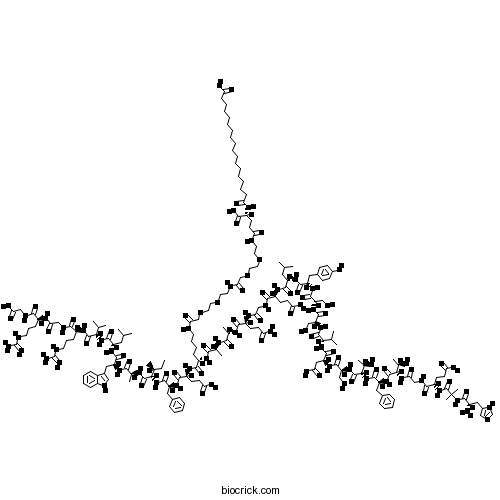NNC 63-0532Potent non-peptide NOP agonist; brain penetrant CAS# 250685-44-0 |

- Mibefradil
Catalog No.:BCC1748
CAS No.:116644-53-2
- Mibefradil dihydrochloride
Catalog No.:BCC1749
CAS No.:116666-63-8
- Cilnidipine
Catalog No.:BCC1083
CAS No.:132203-70-4
- Pregabalin
Catalog No.:BCN2175
CAS No.:148553-50-8
- NP118809
Catalog No.:BCC1807
CAS No.:41332-24-5
Quality Control & MSDS
3D structure
Package In Stock
Number of papers citing our products

| Cas No. | 250685-44-0 | SDF | Download SDF |
| PubChem ID | 56843331 | Appearance | Powder |
| Formula | C27H29N3O3 | M.Wt | 443.54 |
| Type of Compound | N/A | Storage | Desiccate at -20°C |
| Solubility | Soluble to 5 mM in ethanol and to 50 mM in DMSO | ||
| SMILES | CCC(C)C(C(=O)NC(C)C(=O)NC(CC1=CNC2=CC=CC=C21)C(=O)NC(CC(C)C)C(=O)NC(C(C)C)C(=O)NC(CCCNC(=N)N)C(=O)NCC(=O)NC(CCCNC(=N)N)C(=O)NCC(=O)O)NC(=O)C(CC3=CC=CC=C3)NC(=O)C(CCC(=O)O)NC(=O)C(CCCCNC(=O)COCCOCCNC(=O)COCCOCCNC(=O)CCC(C(=O)O)NC(=O)CCCCCCCCCCCCCCCCC(=O)O)NC(=O)C(C)NC(=O)C(C)NC(=O)C(CCC(=O)N)NC(=O)CNC(=O)C(CCC(=O)O)NC(=O)C(CC(C)C)NC(=O)C(CC4=CC=C(C=C4)O)NC(=O)C(CO)NC(=O)C(CO)NC(=O)C(C(C)C)NC(=O)C(CC(=O)O)NC(=O)C(CO)NC(=O)C(C(C)O)NC(=O)C(CC5=CC=CC=C5)NC(=O)C(C(C)O)NC(=O)CNC(=O)C(CCC(=O)O)NC(=O)C(C)(C)NC(=O)C(CC6=CN=CN6)N | ||
| Standard InChIKey | DLSWIYLPEUIQAV-CCUURXOWSA-N | ||
| Standard InChI | InChI=1S/C187H291N45O59/c1-18-105(10)154(180(282)208-108(13)159(261)216-133(86-114-89-200-119-50-40-39-49-117(114)119)170(272)218-129(82-102(4)5)171(273)228-152(103(6)7)178(280)215-121(53-44-72-199-186(192)193)162(264)201-91-141(242)209-120(52-43-71-198-185(190)191)161(263)204-94-151(257)258)230-172(274)131(83-111-45-33-31-34-46-111)219-167(269)126(64-69-149(253)254)214-166(268)122(51-41-42-70-195-144(245)98-290-79-78-289-76-74-197-145(246)99-291-80-77-288-75-73-196-139(240)66-61-127(183(285)286)211-140(241)54-37-29-27-25-23-21-19-20-22-24-26-28-30-38-55-146(247)248)212-158(260)107(12)206-157(259)106(11)207-165(267)125(60-65-138(189)239)210-142(243)92-202-163(265)123(62-67-147(249)250)213-168(270)128(81-101(2)3)217-169(271)130(85-113-56-58-116(238)59-57-113)220-175(277)135(95-233)223-177(279)137(97-235)224-179(281)153(104(8)9)229-174(276)134(88-150(255)256)221-176(278)136(96-234)225-182(284)156(110(15)237)231-173(275)132(84-112-47-35-32-36-48-112)222-181(283)155(109(14)236)227-143(244)93-203-164(266)124(63-68-148(251)252)226-184(287)187(16,17)232-160(262)118(188)87-115-90-194-100-205-115/h31-36,39-40,45-50,56-59,89-90,100-110,118,120-137,152-156,200,233-238H,18-30,37-38,41-44,51-55,60-88,91-99,188H2,1-17H3,(H2,189,239)(H,194,205)(H,195,245)(H,196,240)(H,197,246)(H,201,264)(H,202,265)(H,203,266)(H,204,263)(H,206,259)(H,207,267)(H,208,282)(H,209,242)(H,210,243)(H,211,241)(H,212,260)(H,213,270)(H,214,268)(H,215,280)(H,216,261)(H,217,271)(H,218,272)(H,219,269)(H,220,277)(H,221,278)(H,222,283)(H,223,279)(H,224,281)(H,225,284)(H,226,287)(H,227,244)(H,228,273)(H,229,276)(H,230,274)(H,231,275)(H,232,262)(H,247,248)(H,249,250)(H,251,252)(H,253,254)(H,255,256)(H,257,258)(H,285,286)(H4,190,191,198)(H4,192,193,199)/t105-,106-,107-,108-,109+,110+,118-,120-,121-,122-,123-,124-,125-,126-,127+,128-,129-,130-,131-,132-,133-,134-,135-,136-,137-,152-,153-,154-,155-,156-/m0/s1 | ||
| General tips | For obtaining a higher solubility , please warm the tube at 37 ℃ and shake it in the ultrasonic bath for a while.Stock solution can be stored below -20℃ for several months. We recommend that you prepare and use the solution on the same day. However, if the test schedule requires, the stock solutions can be prepared in advance, and the stock solution must be sealed and stored below -20℃. In general, the stock solution can be kept for several months. Before use, we recommend that you leave the vial at room temperature for at least an hour before opening it. |
||
| About Packaging | 1. The packaging of the product may be reversed during transportation, cause the high purity compounds to adhere to the neck or cap of the vial.Take the vail out of its packaging and shake gently until the compounds fall to the bottom of the vial. 2. For liquid products, please centrifuge at 500xg to gather the liquid to the bottom of the vial. 3. Try to avoid loss or contamination during the experiment. |
||
| Shipping Condition | Packaging according to customer requirements(5mg, 10mg, 20mg and more). Ship via FedEx, DHL, UPS, EMS or other couriers with RT, or blue ice upon request. | ||
| Description | Potent non-peptide agonist for the NOP receptor (EC50 = 305 nM, Ki = 7.3 nM); ~ 12-fold selective over other receptors. Centrally active following systemic administration in vivo. |

NNC 63-0532 Dilution Calculator

NNC 63-0532 Molarity Calculator
| 1 mg | 5 mg | 10 mg | 20 mg | 25 mg | |
| 1 mM | 2.2546 mL | 11.2729 mL | 22.5459 mL | 45.0918 mL | 56.3647 mL |
| 5 mM | 0.4509 mL | 2.2546 mL | 4.5092 mL | 9.0184 mL | 11.2729 mL |
| 10 mM | 0.2255 mL | 1.1273 mL | 2.2546 mL | 4.5092 mL | 5.6365 mL |
| 50 mM | 0.0451 mL | 0.2255 mL | 0.4509 mL | 0.9018 mL | 1.1273 mL |
| 100 mM | 0.0225 mL | 0.1127 mL | 0.2255 mL | 0.4509 mL | 0.5636 mL |
| * Note: If you are in the process of experiment, it's necessary to make the dilution ratios of the samples. The dilution data above is only for reference. Normally, it's can get a better solubility within lower of Concentrations. | |||||

Calcutta University

University of Minnesota

University of Maryland School of Medicine

University of Illinois at Chicago

The Ohio State University

University of Zurich

Harvard University

Colorado State University

Auburn University

Yale University

Worcester Polytechnic Institute

Washington State University

Stanford University

University of Leipzig

Universidade da Beira Interior

The Institute of Cancer Research

Heidelberg University

University of Amsterdam

University of Auckland

TsingHua University

The University of Michigan

Miami University

DRURY University

Jilin University

Fudan University

Wuhan University

Sun Yat-sen University

Universite de Paris

Deemed University

Auckland University

The University of Tokyo

Korea University
- Pedunsaponin A
Catalog No.:BCN8192
CAS No.:250613-27-5
- Cyclo(RGDyK)
Catalog No.:BCC6512
CAS No.:250612-42-1
- (±)-Acetylcarnitine chloride
Catalog No.:BCC6617
CAS No.:2504-11-2
- Excavatin M
Catalog No.:BCN5116
CAS No.:250293-31-3
- PNU 177864 hydrochloride
Catalog No.:BCC7664
CAS No.:250266-51-4
- Boc-His(Dnp)-OH
Catalog No.:BCC3401
CAS No.:25024-53-7
- Otophylloside F
Catalog No.:BCN6441
CAS No.:250217-73-3
- 1,2:4,5-Di-O-isopropylidene-beta-D-fructopyranose
Catalog No.:BCN1475
CAS No.:25018-67-1
- Miriplatin hydrate
Catalog No.:BCC1751
CAS No.:250159-48-9
- Anamorelin
Catalog No.:BCC1362
CAS No.:249921-19-5
- Borreriagenin
Catalog No.:BCN5115
CAS No.:249916-07-2
-
SB-334867 hydrochloride
Catalog No.:BCC4289
CAS No.:249889-64-3
- Salvisyrianone
Catalog No.:BCN4821
CAS No.:250691-57-7
- Antazoline HCl
Catalog No.:BCC4627
CAS No.:2508-72-7
- FRATide
Catalog No.:BCC5821
CAS No.:251087-38-4
- Crebanine
Catalog No.:BCN5117
CAS No.:25127-29-1
- Urotensin II (human)
Catalog No.:BCC5796
CAS No.:251293-28-4
- SU 16f
Catalog No.:BCC7639
CAS No.:251356-45-3
- M344
Catalog No.:BCC2162
CAS No.:251456-60-7
- Tesaglitazar
Catalog No.:BCC7828
CAS No.:251565-85-2
- 5-Chloro-2-nitrobenzoic acid
Catalog No.:BCC8743
CAS No.:2516-95-2
- Acevaltrate
Catalog No.:BCN7127
CAS No.:25161-41-5
- Loline
Catalog No.:BCN2003
CAS No.:25161-91-5
- Isohomoarbutin
Catalog No.:BCN7612
CAS No.:25162-30-5
(8-Naphthalen-1-ylmethyl-4-oxo-1-phenyl-1,3,8-triaza-spiro[4. 5]dec-3-yl)-acetic acid methyl ester (NNC 63-0532) is a novel potent nociceptin receptor agonist.[Pubmed:11053209]
Br J Pharmacol. 2000 Nov;131(5):903-8.
Spiroxatrine was identified as a moderately potent (K:(i)=118 nM) but non-selective agonist at the human nociceptin/orphanin FQ receptor, ORL1. This compound was subject to chemical modification and one of the resulting compounds, (8-naphthalen-1-ylmethyl-4-oxo-1-phenyl-1,3,8-triaza-s piro[4. 5]dec-3-yl)-acetic acid methyl ester (NNC 63-0532) was shown to have high affinity for ORL1 (K:(i)=7.3 nM). NNC 63-0532 showed only moderate affinity for the following receptors (K:(i) values in parentheses): mu-opioid (140 nM), kappa-opioid (405 nM), dopamine D(2S) (209 nM), dopamine D(3) (133 nM) and dopamine D(4.4) (107 nM) out of 75 different receptors, ion-channels and transporters. In functional assays, NNC 63-0532 was shown to be an agonist at ORL1 (EC(50)=305 nM), a much weaker agonist at the mu-opioid receptor (EC(50)>10 microM) and an antagonist or weak partial agonist at dopamine D(2S) (IC(50)=2830 nM). Thus, NNC 63-0532 is a novel non-peptide agonist with approximately 12 fold selectivity for ORL1 and may be useful for exploring the physiological roles of this receptor owing to its brain-penetrating properties.


